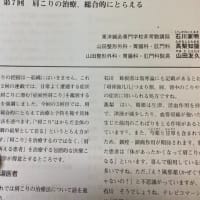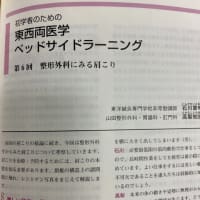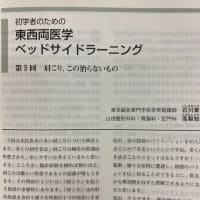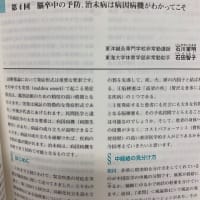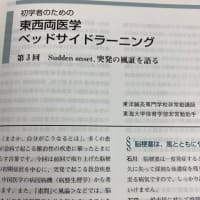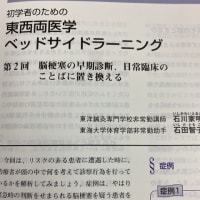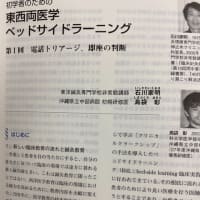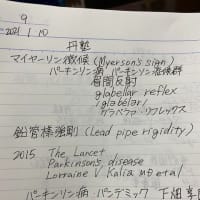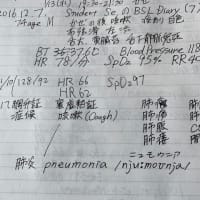2015年7月8日『メドスケープ』
「筋肉マッサージの『フォームローラー』はほんとうに効果あるの?」
Are Foam Rollers for Muscle Massage Really Beneficial?
以下、引用。
「セルフ・マイオフェイシャル・リリース(筋膜リリース)は、効果があるの?」
Self-Myofascial Release Beneficial?
「アメリカのスポーツジムでは、近年、『フォームローラー』が春の花のように満開である」
Over recent years in gyms in the United States, foam rollers have sprouted like flowers in spring.
「メディアは、『フォームローラー』の使用を祝福し、自己管理マッサージ治療の方式を『セルフ筋膜リリース』と呼んで使用することを助けている」
Media reports have celebrated the use of these rollers and other aids for promoting a type of self-administered massage therapy called "self-myofascial release."
「筋骨格の軟部組織治療は、可動域や痛みや筋肉の硬さを柔らかくすると称しており、関節可動域を拡げて、アスレティック・パフォーマンスさえ向上させると言う」
This soft tissue therapy for the treatment of skeletal muscle immobility and pain purportedly soothes muscle soreness, increases range of motion, and even improves athletic performance.
「現在、科学者たちは、比較試験が始まったばかりであると、述べている」
Now scientists have begun to test these claims with controlled trials.
「最近、『アメリカン・カレッジ・オブ・スポーツ・メディスン(ACSM)』で出版された文献レビュー(※1)では、セルフ筋膜リリースには、パフォーマンス向上があり、関節可動域を改善させると断言している。」
A recent review of the published literature and studies presented at the American College of Sports Medicine (ACSM) 62nd Annual Meeting in May challenge assertions about the increased performance benefits of self-myofascial release. But they do support self-myofascial release as way of improving range of motion.
以上、引用終わり。
※1:2015年5月
「セルフ筋膜リリースは、運動前と運動からの回復戦略として有効なのか?文献レビュー」
Is self myofascial release an effective pre-exercise and recovery strategy? A literature review.
Schroeder AN, Best TM.
Curr Sports Med Rep. 2015 May-Jun;14(3):200-8.
以下、記事からの引用。
「セルフ筋膜リリースVSマッサージ治療」
Self-Myofascial Release vs Massage Therapy
「セルフ筋膜リリースでは、人々が自分の軟部組織に自分でマッサージを行う。研究者たちは、このテクニックは専門家である理学療法士による『筋膜リリース』と同じ効果があるということを支持している。」
In self-myofascial release, people massage their own soft tissue. Researchers have supposed that this technique might produce some of the same benefits shown in myofascial release that is administered by physical therapists.
「一つの理論として、『フェイシア(筋膜)』は、外傷への防御反応として固くなる。時間がたつと、コラーゲンは密集して線維化する。そして、結合織における高い弾力性のあるタンパクであるエラスチンは、弾力を失う。これが、筋肉が機能を失って、痛みを引き起こす原因である。『筋膜リリース(マイオフェイシャル・リリース)』の理論によれば、『筋膜リリース』は、このプロセスを逆転させる」
One theory is that fasciae tighten as a protective mechanism in response to trauma. Over time, collagen becomes more dense and fibrous, and elastin—a highly elastic protein in connective tissue—becomes less resilient. This can reduce muscle functioning and cause pain. Myofascial release, in this theory, whether self-administered or administered by someone trained in the technique, might reverse this process.
「付け加えると、いくつかの研究は、障害、疾病、非活動性、炎症は、筋肉組織における繊維の粘着化(fibrous adhesions)を形成し、また、通常の機能を制限させる。『筋膜リリース(マイオフェイシャル・リリース)』は、この粘着化を破壊することが出来る」
In addition, some research suggests that injury, disease, inactivity, and inflammation may cause fibrous adhesions to form in muscle tissue, also limiting its normal functioning. Myofascial release could break these adhesions.
以上、引用終わり。
↑
「筋膜リリース(マイオフェイシャル・リリース)」は、多くの源流があり、ややこしいです(笑)。
一つは、「オステオパシー」の創始者アンドリュー・テイラー・スティルです。
もう一つは、ジャネット・トラベルの「トリガーポイント療法」です。
もう一つは、「ロルフィング」のアイダ・ロルフです。
もう一つは、ドイツの「結合織マッサージ」のエリザベート・ディッケです。
「マイオフェーシャル・リリース®」は、ジョン・F・バーンズ(John F Barns)という、アリゾナ州セドナ在住のカリスマ的理学療法士が1990年代に提唱しました。
↓
John F. Barnes, myofascial release approach®
DVD「マイオファッシャル・リリース(筋膜リリース法)」
ジョンF.バーンズ,P.T全3枚DVD36,000円(←高いわ!)
「Myofascial Release(筋膜リリース)」
竹井 仁(東京都立保健科学大学理学療法学科)
『理学療法科学』Vol. 16 (2001) No. 2 P 103-107
↑
理学療法士の先生方は「®登録商標マーク」のついた治療法が好き過ぎです・・・(笑)。
以下は、「筋膜リリース(マイオフェーシャル・リリース)」のEBMはどうなっているのか?の調査です。
2013年『ジャーナル・オブ・アスレティック・トレーニング』
「整形外科領域での『筋膜リリース(マイオフェーシャル・リリース)』:システマティックレビュー」
Myofascial release as a treatment for orthopaedic conditions: a systematic review.
McKenney K, Elder AS, Elder C, Hutchins A.
J Athl Train. 2013 Jul-Aug;48(4):522-7.
↑
「『筋膜リリース(マイオフェーシャル・リリース)』は、徒手療法として広く行われるようになっている。そのルーツは、1940年代にまでさかのぼり、『マイオフェーシャル・リリース』というコトバが使われたのは、1981年にオステオパスのアンソニー・チラ、キャロル・マンハイム医師によるミシガン大学の講義『マイオフェーシャル・リリース』が最初である。徒手療法の世界で、マイオフェーシャル・リリースは広汎に行われているにも関わらず、その効果は客観的に評価されていない」
Myofascial release (MFR) is one example of a manual therapy that has become widely used. Although its roots can be tracked to the 1940s, the term myofascial release was first coined in 1981 by Anthony Chila, DO; John Peckham, DO; and Carol Manheim, MEd, in a course titled “Myofascial Release” at Michigan State University. Despite the pervasiveness of MFR as a manual therapy, its effectiveness has not been objectively evaluated.
2015年『ジャーナル・オブ・ボディワーク・アンド・ムーブメント・セラピー』
「『筋膜リリース(マイオフェーシャル・リリース)』の効果:ランダム化比較試験のシステマティックレビュー」
Effectiveness of myofascial release: systematic review of randomized controlled trials.
Ajimsha MS et al.
J Bodyw Mov Ther. 2015 Jan;19(1):102-12.
↑
2015年と2013年のシステマティックレビューを読んだ限りでは、『筋膜リリース(マイオフェーシャル・リリース)』の有効性の科学的根拠については、まだ、何も言えないというのが現状だと思います。
以下の2015年のシステマティックレビューの記述は、「Fascia(膜・筋膜)」の研究の記述として面白いです。
↓
以下、引用。
「最近のファッシャ・リサーチ・コングレス(筋膜研究会)は、ファッシア(膜・筋膜)を結合組織システムの軟部組織コンポーネントであり、人間のからだのすみずみにあると定義している。ファッシア(膜・筋膜)の線維性コラーゲン組織は、人体の張力のトランスミッションシステムであると描写されている。」
Recent Fascia Research Congresses (FRC) define fascia as a ‘soft tissue component of the connective tissue system that permeates the human body’ (Huijing and Langevin, 2009). One could also describe them as fibrous collagenous tissues that are part of a body-wide tensional force transmission system (Schleip et al., 2012).
「ファッシア(膜・筋膜)ネットは、靱帯、腱、筋外膜、最も深い筋内膜の層に含まれる。ファッシア(膜・筋膜)というコトバは、硬膜、骨膜、神経周膜、椎間板の線維性カプセル層、呼吸器の結合組織のカプセル組織、腹部の腸間膜も含んでいる。」
The complete fascial net includes dense planar tissue sheets, ligaments, tendons, superficial fascia and even the innermost intramuscular layer of the endomysium. The term fascia now includes the dura mater, the periosteum, perineurium, the fibrous capsular layer of vertebral discs, organ capsules as well as bronchial connective tissue and the mesentery of the abdomen (Schleip et al., 2012).
「ファッシア(膜・筋膜)は、繊維の配列や密度に適した張力ネットワークとつながっている」
Fascial tissues are seen as one interconnected tensional network that adapts its fiber arrangement and density, according to local tensional demands (Schleip et al., 2012).
「2009年のデイや2013年のステッコらの著者、あるいは2011年のヘレン・ランジュバンらは、結合組織が、オーバーユースシンドロームや外傷後に、より固く緊密になることを示唆している。しかし、これはコラーゲン繊維の構成の変化なのか、線維芽細胞によるものなのか、骨基質によるものなのかは不明である。」
Authors such as Day et al., 2009, Stecco et al., 2013) and Langevin et al. (2011)) and colleagues, have suggested that connective tissue could become tighter/denser in overuse syndromes, or after traumatic injuries, but it is unclear if this is due to an alteration of collagen fiber composition, of fibroblasts, or of ground substance.
「同じ著者らは、ファッシア(膜・筋膜)の柔軟性の変化が、緊張や運動器のコーディネーションが弱まることにつながる身体の誤ったアラインメントや貧弱な筋肉のバイオメカにクスとなる可能性を示唆している」
The same authors suggest that the alteration of fascial pliability could be a source of body misalignment, potentially leading to poor muscular biomechanics, altered structural alignment, and decreased strength and motor coordination.
以上、引用終わり。










